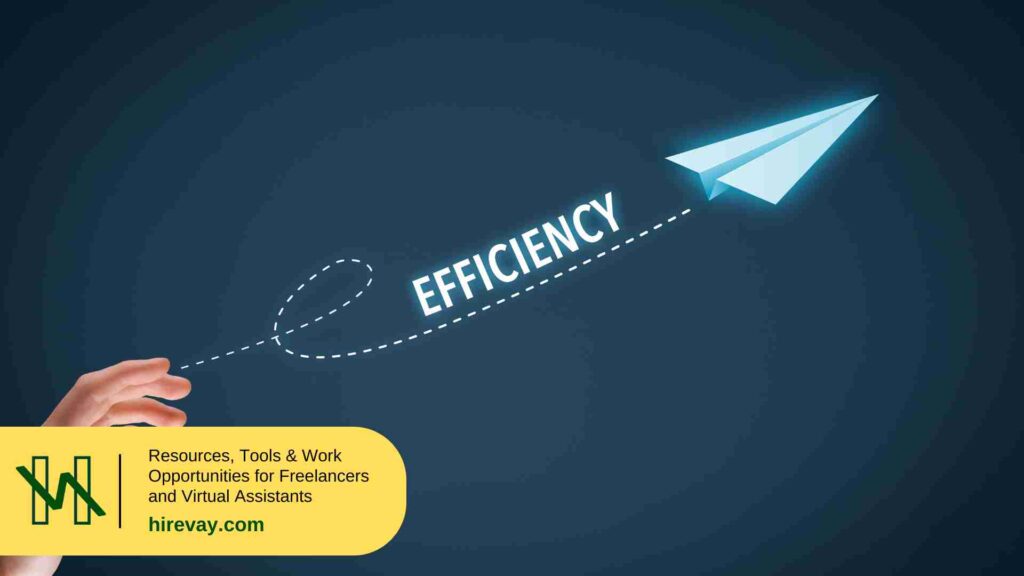Table of Contents

Understanding Virtual Assistant Data Entry
Definition and Scope of Virtual Assistant Data Entry Services
Virtual assistant data entry refers to the process where virtual assistants (VAs) handle the input, management, and organization of data for a business or individual. This data can include anything from simple text entries to more complex tasks like spreadsheet management or database maintenance. VAs work remotely, typically from their own homes or co-working spaces, providing flexibility and cost-effective solutions for businesses of all sizes.
The scope of these services can range from basic data entry tasks to more specialized services such as data mining, data cleaning, and transcribing. The flexibility and adaptability of VAs allow businesses to scale their data entry needs up or down, depending on workload and budget constraints. This professional guide will help you understand the comprehensive capabilities of virtual assistant data entry services and how they can benefit your business.
Key Benefits of Utilizing Virtual Assistants for Data Entry Tasks
Using virtual assistants for data entry offers several empowering benefits that can significantly enhance business productivity:
- Cost Efficiency: Hiring a VA is often cheaper than employing a full-time, in-house staff member. VAs are typically paid hourly or per task, so you only pay for the work completed, allowing for better budget control.
- Flexibility: VAs operate remotely, which means they can work according to your business hours or outside typical office hours to meet tight deadlines.
- Focus on Core Activities: Outsourcing data entry tasks to VAs enables your in-house team to concentrate on high-priority and revenue-generating activities, leading to overall business growth.
- Scalability: As your business grows, the workload increases. VAs provide the flexibility to scale data entry tasks based on current business needs without the hassle of recruitment and training.
- Expertise: Many VAs specialize in specific types of data entry tasks and have the professional experience and skills to perform these tasks accurately and efficiently.
Types of Data Entry Tasks Commonly Handled by Virtual Assistants
Virtual assistants are adept at handling a wide array of data entry tasks. Here are some of the most common types:
- Basic Data Entry: This involves entering data into spreadsheets, word processing documents, or online databases. It’s the most fundamental type of data entry task, often requiring precision and attention to detail.
- CRM Data Entry: Managing customer information in Customer Relationship Management (CRM) systems is crucial for maintaining accurate client records and ensuring effective communication.
- Data Cleaning: VAs can sanitize your records by identifying and correcting errors or inconsistencies in the data, thus ensuring that your database remains accurate and reliable.
- Data Transcription: Converting audio or video recordings into written text is another task VAs can handle. This includes transcribing meetings, interviews, seminars, and webinars.
- Data Mining: Extracting useful information from large datasets requires specialized knowledge and expertise. VAs can perform data mining tasks to pull relevant data points that can inform business strategies.
- Product Entries: For eCommerce businesses, VAs can manage product listings, including adding new items, updating prices, and adjusting descriptions, keeping your online store up-to-date.
- Invoice Processing: VAs can handle invoice entries, ensuring all financial transactions are accurately recorded, aiding in efficient bookkeeping and financial tracking.
You’ll find this information empowering as you start to integrate virtual assistant data entry services into your business strategy. Understanding the types of tasks VAs can handle will allow you to effectively delegate, streamline operations, and enhance productivity. Stay tuned as we delve deeper into how to set up your virtual assistant data entry system in subsequent chapters.

Setting Up Your Virtual Assistant Data Entry System
Virtual assistant data entry can transform your business efficiency. But without the right setup, it’s like trying to drive a car without wheels. In this chapter, you’ll find this information empowering as it walks you through the essential tools, workflows, and security measures necessary for an effective virtual assistant data entry system.
Essential Tools and Software for Efficient Data Entry Management
Getting started with virtual assistant data entry requires the right digital toolkit. Here’s a lineup of essential tools to streamline your processes:
- Spreadsheet Software: Tools such as Microsoft Excel and Google Sheets are indispensable for data entry. They provide powerful functions, ease of use, and widespread compatibility.
- Database Management Software: Programs like Microsoft Access and Airtable allow you to handle complex data more efficiently and ensure that your data is well organized.
- Project Management Tools: Trello, Asana, and Monday.com help you assign tasks, track progress, and keep your virtual assistants (VAs) aligned with deadlines and priorities.
- Communication Platforms: Ensure seamless communication with apps like Slack, Zoom, or Microsoft Teams. This allows for real-time discussions, file sharing, and virtual meetings.
- Automation Tools: Software like Zapier and Integromat can automate repetitive tasks, reducing manual workload and improving accuracy.
These tools not only help in task management but also enhance productivity and collaboration between you and your VAs.
Establishing Clear Workflows and Standard Operating Procedures
One of the keys to success in virtual assistant data entry is clarity in workflows and operations. Establishing detailed workflows ensures your VAs understand their tasks and execute them efficiently.
Defining Workflows
- Task Assignment: Clearly outline who is responsible for each task. Use project management tools to avoid overlap and ensure accountability.
- Task Execution: Specify the steps to complete each task. Break down processes into smaller, manageable parts and document these steps thoroughly.
- Quality Control: Set up multi-level checks to maintain data accuracy. Have senior VAs review the work done by juniors, or use audit tools for automated checks.
- Feedback Loop: Implement regular feedback sessions to address any mistakes or inefficiencies, providing an opportunity for continuous improvement.
Standard Operating Procedures (SOPs)
Developing SOPs is essential for consistency and scalability. Here’s how you can create effective SOPs:
- Document Everything: Write down every step of your processes, no matter how small.
- Visual Aids: Use screenshots, flowcharts, and videos to make complex procedures easy to understand.
- Accessibility: Store SOPs in a shared location like Google Drive or within a project management tool so that all team members can access them.
- Reviews and Updates: Regularly update SOPs to reflect any changes in procedures or tools, ensuring they remain relevant and effective.
Implementing Security Measures and Data Protection Protocols
Data security is a top priority when dealing with sensitive information. Implement robust security measures to safeguard your data and maintain compliance with regulations.
Security Measures
- Encryption: Use encrypted communication channels for data transmission. Tools like VPN services and end-to-end encrypted messaging apps ensure data security during transit.
- Access Control: Limit data access based on roles. Ensure only authorized personnel have access to sensitive information, using tools like Google Workspace’s administrative controls.
- Secure Passwords: Encourage the use of strong, unique passwords and two-factor authentication (2FA) to enhance account security. Password managers like LastPass or 1Password can help.
Data Protection Protocols
- Data Backup: Regularly back up data to secure locations. Cloud services such as AWS or Azure offer reliable backup solutions.
- Compliance Adherence: Ensure your data management practices comply with regulations such as General Data Protection Regulation (GDPR) or the California Consumer Privacy Act (CCPA). This might include training VAs on compliance requirements and conducting regular audits.
- Incident Response: Have a plan in place for potential data breaches. Define clear steps for your team to follow in case of a security incident, including whom to notify and how to mitigate damage.
By incorporating these tools, workflows, and security measures, you’re laying a strong foundation for your virtual assistant data entry system. This structured approach not only boosts productivity but also ensures data integrity and security.

Best Practices for Virtual Assistant Data Entry Management
Creating a well-managed data entry system involves establishing clear guidelines, maintaining quality control, and fostering effective communication with your virtual assistants. You will find this information empowering as it equips you with the tools needed to optimize your data entry operations.
Creating Detailed Guidelines and Quality Control Measures
Detailed guidelines are the backbone of any efficient data entry system. They ensure that tasks are completed accurately and consistently. Start by crafting comprehensive guidelines that cover every aspect of the data entry process:
- Task Descriptions: Clearly outline what each task involves, including specific steps and any particular formats to follow.
- Standard Operating Procedures (SOPs): Develop SOPs to provide a consistent framework for data entry tasks. These should include step-by-step instructions and examples to eliminate ambiguity.
- Data Validation: Implement data validation rules to check for errors and inconsistencies. This might include setting up automated checks within spreadsheets or databases.
- Quality Control Measures: Develop protocols for regular quality audits. This helps to ensure that the data entered meets your quality standards. Designate a team member to conduct random checks and review a sample of entries regularly.
Quality control measures are crucial for maintaining accuracy. Establish metrics to measure performance, such as error rates and the time taken to complete tasks. Regularly review these metrics to identify areas for improvement.
Effective Communication Strategies with Virtual Assistants
Clear and consistent communication is critical to the success of your data entry system. Here are some strategies to enhance communication with your virtual assistants:
- Regular Updates: Schedule regular check-ins, either weekly or daily, to discuss progress, address any issues, and provide feedback.
- Communication Tools: Utilize tools like Slack, Microsoft Teams, or Zoom for real-time communication. These platforms enable easy interaction and quick resolution of issues.
- Documentation: Ensure all guidelines, SOPs, and other important documents are easily accessible in places like Google Drive or Dropbox. This helps your virtual assistants to reference and follow protocols accurately.
- Feedback Loop: Create a feedback loop where virtual assistants can share their input on processes and suggest improvements. This not only empowers them but also fosters a collaborative working environment.
Effective communication helps mitigate misunderstandings and keeps everyone aligned with project goals.
Methods for Tracking Productivity and Maintaining Accuracy
Tracking productivity and maintaining accuracy are essential for optimizing your data entry system. Here are some methods to help you achieve this:
- Productivity Tools: Use tools like Trello or Asana to keep track of tasks and monitor progress. These platforms provide an overview of all pending and completed tasks, helping you to manage workloads effectively.
- Time Tracking: Implement time tracking tools like Toggl or Hubstaff to measure how much time virtual assistants spend on each task. This data can reveal productivity patterns and help you identify areas where efficiency can be improved.
- Performance Metrics: Establish key performance indicators (KPIs) such as the number of entries processed per hour, error rates, and turnaround times. Regularly review these metrics to assess performance.
- Training and Development: Provide ongoing training to help virtual assistants improve their skills. This can be in the form of webinars, workshops, or online courses.
Maintaining a high level of accuracy is crucial. Use data validation techniques to identify and correct errors promptly. Establish a system for regular reviews and audits to ensure data integrity.
By implementing these best practices, you can create a robust data entry management system that enhances efficiency and accuracy. This professional guide will help you understand how to manage your virtual assistant data entry tasks effectively, ensuring seamless operations.
With a structured approach, empowering communication, and careful monitoring, you can elevate your data entry system, resulting in improved productivity and accuracy. This dedication to optimizing processes will pave the way for a more streamlined and effective business operation.

Maximizing Efficiency Through Automation
Achieving efficiency in your business processes is essential, and you can significantly enhance productivity by embracing automation. In this chapter, we will explore how to identify tasks suitable for automation, integrate automated tools with virtual assistant workflows, and balance automation with human oversight.
Identifying Tasks Suitable for Automation
Before integrating automation into your virtual assistant (VA) data entry system, identifying which tasks are most suitable for automation is crucial. Here are some key characteristics of tasks ideal for automation:
- Repetitive: Tasks that require the same sequence of actions repeatedly, such as data entry, can be automated to reduce human error and save time.
- Rule-based: Tasks with clear and consistent criteria, like invoice processing and data validation, are good candidates for automation.
- High-volume: Tasks involving large amounts of data, such as data scraping and migration, can benefit from the speed and accuracy of automated tools.
- Time-sensitive: Tasks requiring quick turnaround times, like real-time reporting and data updates, are prime candidates for automation.
By focusing on these types of tasks, you can maximize the productivity gains from automation while freeing up your VAs for more strategic and creative activities.
Integrating Automated Tools with Virtual Assistant Workflows
Seamlessly integrating automated tools into your VA workflows is vital for achieving synergy between human and machine tasks. Here’s how:
- Evaluate Automation Tools: Choose tools that best fit your business needs, such as robotic process automation (RPA) software, optical character recognition (OCR), and data extraction tools.
- Train Your Virtual Assistants: Ensure your VAs are familiar with the automation tools and understand how to use them effectively. Providing adequate training on these tools will enhance their functionality.
- Implement Incrementally: Introduce automation gradually. Start with a few tasks to identify potential challenges and refine the process before a full-scale implementation.
- Monitor and Adjust Workflows: Regularly review and adjust workflows to ensure automation tools are functioning correctly and VAs are adapting well to the changes.
By systematically integrating automation tools into your workflows, you can achieve a smooth transition and optimize your VA operations.
Balancing Automation with Human Oversight
While automation can significantly enhance efficiency, human oversight remains essential to maintain accuracy and quality. Consider these best practices for balancing automation with human oversight:
- Supervise Automated Processes: Regularly monitor automated tasks to ensure they are producing accurate results. Even the best automated systems can encounter issues that require human intervention.
- Establish Quality Control Checkpoints: Implement checkpoints where human VAs verify the output of automated tasks. This ensures that errors are caught and corrected promptly.
- Prioritize Critical Thinking Tasks: Assign tasks that require judgment, decision-making, and nuanced understanding to your VAs. Automation can handle straightforward tasks, but human insight is invaluable for complex problem-solving.
- Encourage Collaboration: Foster a collaborative environment where VAs can provide feedback on automation processes. Their insights can help refine and improve the system.
By maintaining a balance between automation and human oversight, you can leverage the strengths of both elements to achieve optimal efficiency and accuracy in your data entry operations.
Understanding how to effectively integrate automation into your VA workflows will empower you to streamline operations, reduce manual errors, and improve productivity. As you continue to enhance your data entry processes, remember to measure success through key performance indicators, cost savings, and productivity improvements.

Measuring Success and ROI
Key Performance Indicators for Virtual Assistant Data Entry
To measure the success of your virtual assistant (VA) data entry system, it’s essential to identify key performance indicators (KPIs). These metrics offer valuable insights into productivity, accuracy, and overall efficiency. Some critical KPIs include:
- Accuracy Rate: Tracks the percentage of correct data entries over a specific period. Aim for an accuracy rate of 98% or higher to ensure data integrity.
- Turnaround Time: Measures the time taken to complete data entry tasks. Shorter turnaround times often indicate a more efficient process.
- Error Rate: This KPI tracks the number of errors made during data entry. Maintaining a low error rate, ideally below 2%, is crucial for maintaining data quality.
- Volume of Data Processed: Tracks the number of data entries completed within a set timeframe. Higher volumes processed with consistent quality signal high efficiency.
- Task Completion Rate: Measures the percentage of tasks completed on time. Aim for a completion rate close to 100% to ensure deadlines are consistently met.
- User Feedback: Collect feedback from users or departments that interact with the VA data entry outputs. Positive feedback indicates user satisfaction and reliability.
These KPIs will provide you with a clear picture of how well your VA data entry system is performing and where improvements may be necessary.
Calculating Cost Savings and Productivity Improvements
Understanding the return on investment (ROI) involves calculating both cost savings and productivity improvements. These calculations will help you justify the use of VAs and optimize the value they bring to your business.
- Cost Savings: Calculate the cost savings by comparing the expense of employing in-house personnel versus VAs. Consider aspects such as salaries, benefits, workspace, and equipment. For instance, if employing an in-house data entry clerk costs $3,000 monthly and a VA costs $2,000, the savings would be significant annually.
- Productivity Improvements: Assess productivity improvements by evaluating changes in task completion rates and accuracy before and after deploying VAs. Productivity can be quantified by calculating the increase in volume processed or the reduction in turnaround time. For example, if the task completion rate improved from 90% to 98% after hiring VAs, this showcases enhanced productivity.
By systematically analyzing cost savings and productivity boosts, you can demonstrate the tangible benefits of using VAs for data entry tasks.
Strategies for Continuous Improvement and Optimization
To sustain and enhance the efficiency of your VA data entry system, continuous improvement and optimization are paramount. Here are some strategies to consider:
- Regular Training: Keep your VAs up-to-date with the latest tools, software, and best practices in data entry. Training ensures VAs’ skills remain sharp and relevant.
- Feedback Loop: Implement a feedback loop where VAs receive regular performance reviews and constructive feedback. This allows for ongoing development and correction of any errors quickly.
- Process Audits: Conduct periodic audits of data entry processes to identify bottlenecks or inefficiencies. Use these insights to streamline workflows and eliminate redundancies.
- Technology Integration: Continually integrate new technologies that can automate repetitive tasks, improve accuracy, and decrease processing times. AI-driven tools and advanced software can significantly enhance data entry capabilities.
- Data Security: Update security measures regularly to protect sensitive data. Employ encryption, two-factor authentication, and regular security audits to mitigate risks.
By embracing these strategies, you will foster a culture of continuous improvement, ensuring your VA data entry system remains efficient, accurate, and robust.
Combining these comprehensive approaches to evaluate performance and optimize processes creates a sustainable framework for managing virtual assistant data entry. This not only advances your business operations but also enhances the value added by virtual assistants.

Overcoming Common Challenges
In the dynamic world of virtual assistant (VA) data entry management, challenges are inevitable. Nonetheless, addressing these common hurdles can significantly enhance the performance and reliability of your data entry operations. Here, we explore how to tackle quality control and accuracy issues, manage time zones and communication barriers, and troubleshoot technical difficulties and system integration problems.
Addressing Quality Control and Accuracy Issues
Maintaining high-quality and accurate data entry is crucial for the success of your business processes. To ensure excellence, consider the following strategies:
- Implement Thorough Training Programs: Empower your virtual assistants by providing comprehensive training that emphasizes accuracy and attention to detail. Regularly update training modules to keep up with new tools and protocols.
- Establish Clear Guidelines: Create detailed instructions and standard operating procedures (SOPs) for data entry tasks. This professional guide will serve as a reference, reducing misunderstandings and ensuring consistency.
- Regular Audits and Feedback: Conduct periodic audits to assess the accuracy and quality of the data entered. Provide constructive feedback to your VAs, highlighting areas for improvement and celebrating successful completions.
- Leverage Quality Control Tools: Use software tools that offer built-in checks and validations to minimize errors. Automated tools can help catch mistakes early, preventing them from escalating.
Managing Time Zones and Communication Barriers
Effective communication is key to seamless collaboration, especially when working with VAs across different time zones. Here’s how you can manage these challenges:
- Set Overlapping Work Hours: Identify overlapping hours where both you and your VA can communicate in real-time. Tools like World Time Buddy can help you find convenient meeting times.
- Utilize Communication Tools: Utilize communication platforms like Slack, Microsoft Teams, or Zoom to ensure constant and clear interaction. These tools also support asynchronous communication, making it easier to stay connected despite time zone differences.
- Document Everything: Documentation is essential. Use project management tools like Trello or Asana to track progress, set deadlines, and share updates. This ensures that everyone is on the same page, irrespective of their local time.
- Cultural Sensitivity: Be mindful of cultural differences and holidays that might affect your VAs’ availability. Promote an inclusive environment by respecting these variations.
Troubleshooting Technical Difficulties and System Integration Problems
Technical difficulties can disrupt your data entry processes, but by being proactive, you can minimize their impact. Here’s how you can address these challenges:
- Invest in Reliable Technology: Ensure your VAs have access to high-quality hardware and software tools. A reliable internet connection, secure VPN, and updated systems are essential for smooth operations.
- Provide Technical Support: Offer quick access to IT support for your VAs. Whether through a dedicated IT team or a reliable third-party service, timely assistance can resolve issues before they escalate.
- System Integration: When integrating new tools or software, involve your VAs in the process. Provide necessary training and ensure compatibility with existing systems to avoid disruptions.
- Regular Backups: Implement regular data backup protocols to prevent data loss in case of technical failures. Services like Google Drive or Dropbox can automate this process and provide additional security.
By efficiently addressing these common challenges, you will create a more reliable and effective virtual assistant data entry system, ensuring high-quality, error-free data that drives your business forward. As you continue to refine your processes, keep these strategies in mind to maintain a professional and empowering working relationship with your virtual assistants. Remember to monitor performance regularly, and always be on the lookout for areas to further optimize your operations.
Related Posts
Setting Up a Home Office for Productivity
Working from home is becoming the new normal for many of us. Whether you’re a…
Read Post »
Marketing Yourself as a Freelancer: A Complete Guide
In today’s competitive freelancing world, marketing yourself effectively can be the difference between being fully…
Read Post »
Networking Tips for Remote Freelancers: A Complete Guide
As a remote freelancer, networking might feel a little different compared to traditional in-person events,…
Read Post »